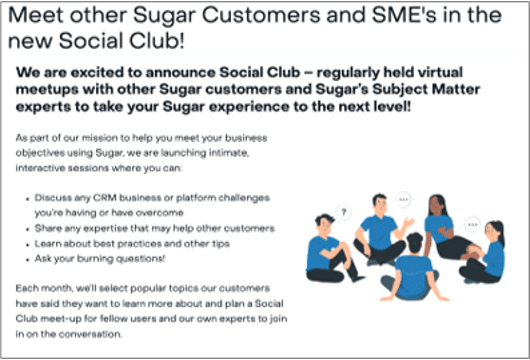6 Best Practices to Drive CRM Adoption
If you’re struggling to increase your CRM adoption rates, you should know you’re not alone. According to one of our most recent reports, 34% of the respondents claim that technology adoption is one of the most prominent CRM challenges across their organization.
While many think there is a quick fix for this struggle, the truth is that you’ll have to work on developing a rock-solid adoption strategy and regularly chat with stakeholders for feedback and recommendations.
While this seems somewhat tricky, we have a series of tips, tricks, and best practices that will help you get those adoption numbers high.
1. Tailor your Technology to Support your Processes
Instead of changing processes and workflows to fit your CRM capabilities, we recommend looking into how users in various roles go about their day-to-day and selecting the tools that fit into their daily processes. Your technology should work with you, not against you. So, being mindful of your CRM’s customization capabilities to support and enhance existing workflows and processes is a great way to ensure higher adoption rates.
You should also double-check that your CRM is the central hub of your operations. If you operate on multiple overlapping platforms or systems, certain features and capabilities may duplicate, and users might end up using a single solution at their own decision.
Sometimes, they may decide they prefer other tools than your CRM. Your CRM should be the single source of truth and information for your business, and employees deciding to use other overlapping systems might affect the accuracy and transparency of your CRM data.
So, simplify your tech stack so that it offers all the necessary capabilities and enhances existing workflows to see adoption rates increase.

2. Give Your Teams a Voice
The success or failure of any project depends on whether your vision is shared by the rest of the organization and, most importantly, your users. You may think there is only one right way to use your technology. However, daily users are the ones who can give you real-life feedback.
Assign team managers to gather feedback from team users as early as possible in the implementation and adoption journey. This will provide you with a clear picture of how the CRM is being used, if it meets specific requirements and criteria that you set, or if it lacks essential capabilities and features that your teams need to effectively carry on with their daily tasks and duties.
Here’s how to effectively involve team feedback in your technology adoption process since these rules don’t apply only to CRM adoption.
- Involve team members in the deployment and adoption process
- Encourage their participation through incentivization and CRM usage reports
- Incorporate their feedback when available and be mindful of their needs regarding features and functionality.
3. Identify your Champions
If adoption is starting to seem more difficult than originally perceived , you can include the usage of champions from within the organization or even outside of it. Subject-matter experts can model proper usage of the newly implemented solution for your teams and ensure processes and workflows between the teams work as intended.
CRM implementation is a company-wide initiative that affects all team members, regardless of department. This is why you should strive to connect with individual team members and check-in. Here are some great tips you can use in the process:
- Collect user feedback
- Communicate CRM benefits through all available channels
- Identify gaps in workflows, usage, and functionality and fix those
- Ease transitioning from legacy systems to the new solution
To identify in-house usage champions, look into the CRM data: who logs in the most, who engages the most in your community channels, who leverages the best capabilities and functionality, etc.
Again, you should incentivize and keep employees accountable when adopting new tech solutions into your stack. You can set adoption KPIs into your CRM and use reporting to measure initiative success. When you identify gaps and can link them to a particular coaching need, discuss with your vendor and account manager and see if you can schedule coaching and training sessions in the areas where you need to improve adoption. Education materials and resources are also crucial in this step. If your CRM vendor also has a knowledge base, encourage employees to refer to it when in doubt.

Lastly, be positive when concerns are voiced and feedback is delivered. This should also expand to situations where employees progress in adopting and including the new system in their daily activities.
4. Communication is Key
CRM implementation and adoption is lengthy, and you will need to constantly disseminate information about the process along the way. We all know that not all employees have the same preferred communication methods, so you’ll also have to be mindful of this aspect. In your dissemination efforts, include varied forms of communication (email, video, messaging app, intranet site or webpage, etc.).
For successful communication, especially in such complex initiatives, you’ll have to:
- Break information into bite-sized pieces
- Reiterate the same information often
- Use multiple “messengers” to deliver the same message.
This will help you ensure that everybody across your organization is exposed to the same information, and you’re more likely to boost adoption rates along the way.
5. Leverage Early Momentum and Enthusiasm
New initiatives are often met with enthusiasm, especially within companies lacking a way to centralize and effectively leverage data previously to implement a CRM solution. To increase your adoption rates, it’s always a good idea to use the initial momentum and enthusiasm to your advantage and support it with ongoing support and reinforcement. This can be achieved through:
- Regular training sessions at a cadence that is established at a company-wide level, accounting for every stakeholder’s availability
- “Office hours” set up in your CRM
- New-hire training will be necessary. Think of who will be assigned to this task and ensure they have the level of experience and knowledge to pass information to new employees effectively.
- Gamification of the training and adoption process. You can implement a badge or point system where you reward new achievements in terms of usage and adoption.
It’s always a good idea to periodically evaluate your technology and processes. Your business evolves, and so should your CRM. For this, you can implement a ticketing system where users who identify gaps in the systems open up tickets for feature requests or feedback, for example. Another good way to ensure your CRM is evolving with your business is through admin-level users. They can always track and document what new features, capabilities, and customizations they are building within your CRM.

6. Foster Peer Engagement
While educational content and training are valuable in boosting CRM adoption, informal training is also essential. Learning from adoption champions is sometimes more effective than presenting your teams with educational content. Some employees absorb information better when processes and workflows are shown to them rather than when they read about said processes and workflows.
Here are a few tips that will help you foster peer engagement in the adoption process:
- Create the necessary space and framework for peer-to-peer networks and informal collaboration
- Identify internal “champions” who can support these informal networks
- Create a space for engagement, especially for remote workers through chatbot tools or intranet solutions where tips and tricks can be shared.
While user adoption is one of the areas where most companies struggle when deploying new solutions, a set of best practices and a solid adoption strategy will help you overcome these. Besides, ongoing support and training from your CRM vendor is just as valuable as your adoption strategy.
If you want to learn about the hottest CRM trends you’ll see in 2024, check out our 2024 State of CRM Report or get in touch with us and let’s chat!



